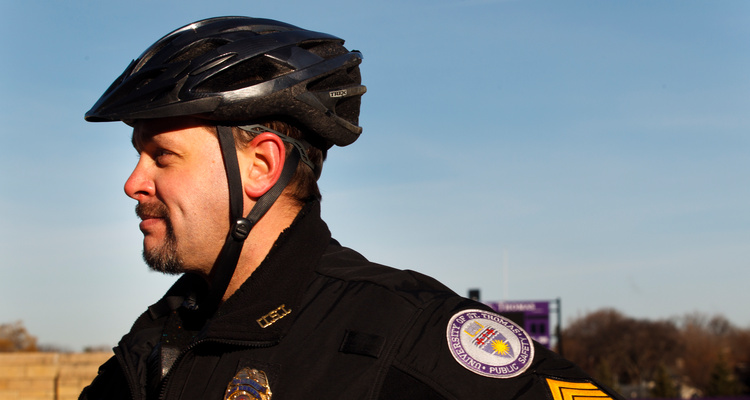The personal transportation boom envisioned by Segway inventor Dean Kamen may have fizzled, but law enforcement and public safety officials across the nation have embraced the two-wheeled marvel – at least for certain tasks.
In St. Paul, the West Summit Neighborhood Advisory Committee, often referred to by its acronym – WSNAC – purchased a Police Package Segway i2 for $6,914.81 in March 2011. It was viewed as a tool for the St. Paul Police Department to better conduct weekend patrols of the neighborhood surrounding St. Thomas during fall and spring months.
“WSNAC was interested in funding the Segway as a way to make it easier for Public Safety and off-duty St. Paul police officers while working for St. Thomas to respond to emergency situations more quickly,” remarked John Hershey, St. Thomas’ neighborhood liaison. The Segway can achieve speeds of up to 14 mph.
“The concept was that the council would purchase a Segway and it would allow police officers in the neighborhood to be able to hear more and see more,” said Dan Meuwissen, director of Public Safety. “Turns out the police weren’t really in favor of using it. They just didn’t want to run over something in the middle of the night and fall off it. So they chose not to use it.”
The Segway rolls on, however. It has found a home and a purpose with Public Safety. “It’s an outstanding tool,” Meuwissen said. He points out that it improves officers’ response time, especially if they need to go from one end of the campus to the other, it’s quick, it’s agile, and it has anti-theft features. It’s also battery powered and it even can be used indoors. But most importantly, it turns out, it “opens doors.”
As versatile as the Segway is, even Kamen couldn’t have imagined that his invention, despite all that it can do, could open doors. But it has on the St. Thomas campus.
“We have great interaction with students because they all come up and want to talk about it, and that opens the door for us to visit with the community, so it’s fantastic in that approach,” Meuwissen said.
You can do much of the same on a bike, he added, “but you don’t get the attention on a bike that you get on a Segway, so you don’t really get the questions and the ‘Hey, that’s cool’ type of thing. That opens the door for us to talk to the community.”
Sgt. Jason Gillen has used the Segway the most among Public Safety’s officers. He tries to utilize it at least once a week.
“It’s fairly new in law enforcement. I don’t believe there’s a lot of tactical training that’s been brought forward with how to utilize the Segway; that’s why it’s kind of in the experimental phase with us as we don’t know exactly how it can be best utilized yet,” Gillen said. “It can be cumbersome at times. It can be a little sensitive when parking, for instance. I don’t know how I would respond yet if I were to come in contact with an emergency situation – what kind of time is involved with making sure this tool is secure before I go on to address another situation. There are a lot of unknowns with it yet.”
But one thing Gillen knows for sure, and which he has experienced, is the Segway’s public relations value while riding around campus. “Everybody’s got what Segway likes to call The Segway Smile,” he said. And that, no doubt, would make inventor Kamen smile, too.







